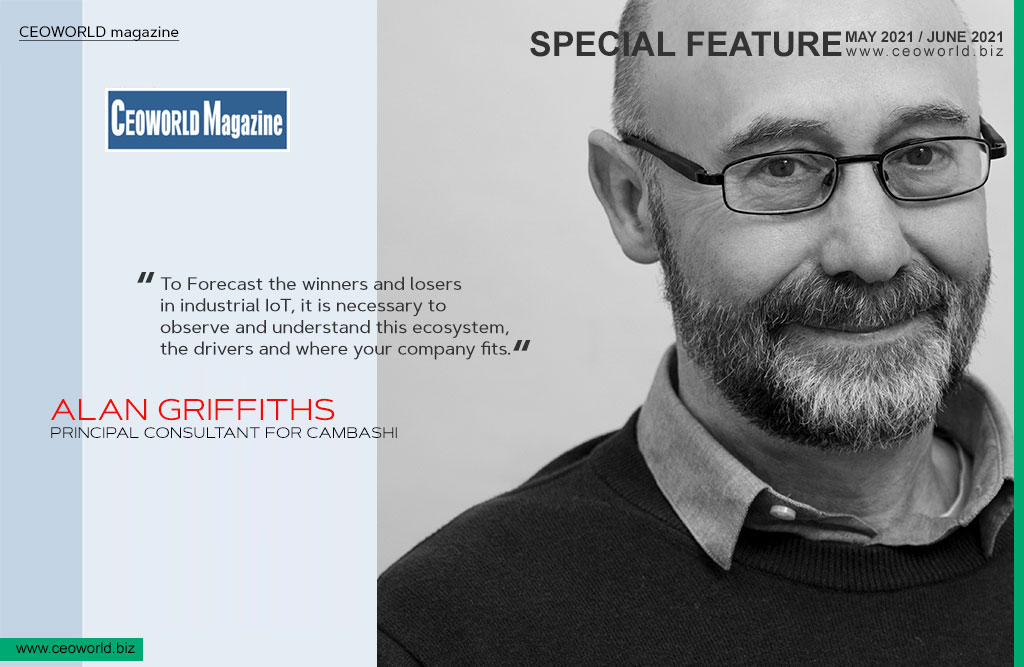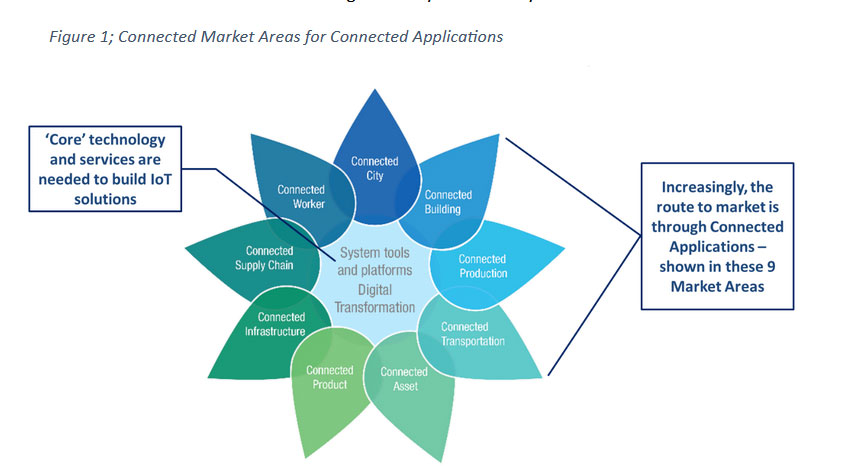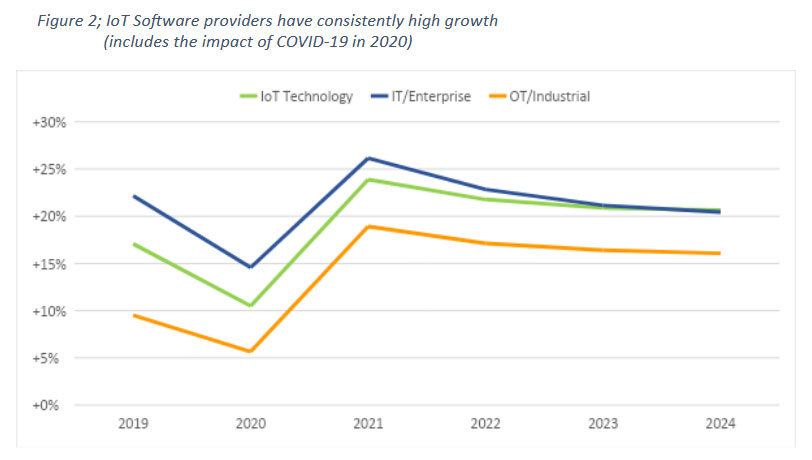Industrial IoT and the disrupters

As a market research, industry analyst and consulting firm, our independent research and analysis shows that – although much of the hype has subsided – the industrial IoT (IIoT) industry has consistently higher growth than the main industrial OT (Operational Technology) and IT companies. But disrupters, for example from the semiconductor, automotive and telco sectors, are emerging to threaten established IoT companies.
Organizations and investors operating in this area need to understand the existing marketplace and the potential for disruption when making decisions, assessing trends, and developing effective marketing strategies.
State of the established IIoT industry and Connected Market Areas
The industrial IoT market is large and growing, and the term ‘connected’ is more important than ‘IoT’ in defining its reach. Providers from ‘OT,’ ‘IT’ and ‘pure IoT’ backgrounds are well-established, and ‘ET’ (Engineering Technology) companies play an important role. The IIoT market is fragmented, with large and small providers from many different backgrounds. Many offer IoT platforms, some are totally focused on building Connected Applications using IoT, while others are ‘testing the water’ with entry-level solutions, sometimes embedded in products.
By defining nine Connected Market Areas as shown in Figure 1, and analyzing frequent Use Cases we can measure the market with granularity and identify trends.
Consistently high growth in companies offering industrial IoT software
From our analysis, the IIoT/Connected Applications software market shows consistently high growth. Figure 2 below shows three groups of IoT provider: ‘pure’ IoT companies; IT/Enterprise software companies that have IoT solutions; and ‘OT’ companies with IoT divisions.
Pure IoT companies are represented by companies such as C3.ai, PTC and RTI.
‘IT’/Enterprise companies with IoT divisions include Amazon AWS, IBM, Microsoft, Oracle, SAP, and Software AG.
‘OT’ companies with IoT divisions include ABB, Bosch, Emerson, GE Digital, Hitachi, Honeywell, Rockwell Automation, Schneider Electric, and Siemens Digital Industries.
This growth is higher than that of the main operational technology (OT) or IT/enterprise software companies. For example, the parent OT companies listed above shrank on average by 15% in 2020 and are only projected to grow at 5% in 2021 and 2022.
IoT disrupters: semiconductor, automotive and telco
The potential IoT market is so diverse that disrupters could come from many directions; three emerging sectors are semiconductor producers, the automotive market, and telcos.
Involved in IoT since its inception, semiconductor producers and designers have increasingly enhanced software capability. The semiconductor front runners (ARM, Intel, NVIDIA, Qualcomm, Samsung, and Texas Instruments) all provide software to support IoT applications such as industrial automation and autonomous vehicles.
Automotive companies are already among the world’s biggest software developers, and they are increasingly focusing on the smart, connected vehicle – a great example of an IoT ‘thing.’ If all Toyota’s software developers were in one company, it would easily be in the world’s top ten. Audi recently announced the formation of CARIAD to centralize software development across the VW/Audi group with a focus on connected/autonomous, electric vehicles. CARIAD will have over 10,000 employees, making it the second biggest software organization in Europe after SAP. Electric car companies Li Auto, Nio and Xpeng are well established in China and expanding around the world. Renault just launched Software République with Atos, Dassault, ST Microelectronics and Thales; this will foster collaboration and start-ups to create innovative mobility solutions and systems.
Most leading telcos support connectivity as a natural extension to communications. 5G is an enabler for IoT as it expands the spectrum and range of applications down to the device. Edge computing is used to process data closer to the device and avoid latency issues. Telcos such as AT&T, Deutsche Telekom, NTT and Verizon offer their own connected applications and have a significant market share.
Friend or foe?
All the disrupters above are potential competitors in the IoT/Connected Applications market – but are they friends or foes?
Cambashi’s view is that – rather than displacing current providers – these ‘new’ entrants will forge alliances in a complex ecosystem. This is illustrated by:
- Semiconductor producers: Intel recently announced it is engaging with the technology ecosystem – including IBM – in its latest ‘IDM 2.0’ vision for next-generation chips. NVIDIA is working closely with ARM to provide technology to the automotive sector through VW/Audi, Toyota and others, and to the AEC sector with Autodesk and Bentley Systems.
- Vehicle/device makers: There are many collaborations between auto and tech companies, such as the Autonomous Vehicle Computing Consortium (AVCC) involving ARM, Bosch, GM, NVIDIA, NXP and Toyota, and SAE International, which defines levels of automated driving and safety criteria.
- Telcos are partnering with IT/Enterprise companies. For example, IBM through its ‘IBM Cloud for Telecommunications’ program, is working with the world’s leading telcos to enhance their enterprise offerings to include new cloud technologies. Microsoft and AT&T announced a strategic alliance aimed at enabling new 5G, cloud and edge computing solutions to drive enterprise capabilities for companies around the world.
Due to its rapid growth, the industrial IoT market is of great interest to software developers and investors. The route to market for IIoT is through Connected Applications that link real-world ‘things’ to information systems, and leverage AI (Artificial Intelligence), ML (Machine Learning) and other analytic capabilities to deliver business benefits. Connected Applications help drive digital transformation, which typically requires connected technology. A sign of a maturing market shows investment in IoT technologies is rarely standalone; most industrial automation projects involve IoT which Connected Applications deliver as part of a broader solution that often includes enterprise systems such as ERP, PLM/CAx, MOM and BIM. Expect disrupters to emerge that are not currently recognized as IoT companies.
To forecast the winners and losers in industrial IoT, it is necessary to observe and understand this ecosystem, the drivers and where your company fits.
Written by Alan Griffiths.
Add CEOWORLD magazine to your Google News feed.
Follow CEOWORLD magazine headlines on: Google News, LinkedIn, Twitter, and Facebook.
Copyright 2024 The CEOWORLD magazine. All rights reserved. This material (and any extract from it) must not be copied, redistributed or placed on any website, without CEOWORLD magazine' prior written consent. For media queries, please contact: info@ceoworld.biz










